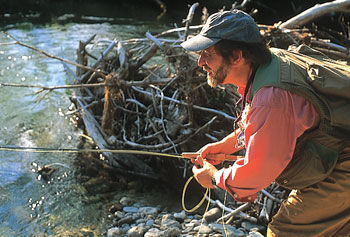Tips for Winter Trout

Tom Rosenbauer concentrates on a
small Vermont Stream
Want to have more success fishing for trout the rest of the winter? Here are some tips and fly suggestions to increase your odds.
1. In winter, trout won’t move more than a few inches for your fly and they’ll be close to the bottom. So, fish your flies deep and slowly. Your best bet is a nymph fished dead-drift.
2. Winter streams are typically very low and clear, so keep your tippet as long and light as possible. You often need to go to 6X or 7X with small nymphs. Mirage Fluorocarbon can really give you an advantage because of its transparency.
3. In tailwaters and spring creeks with stable water temperatures, you may find trout rising to midges any time from dawn to dusk. Early mornings are often surprisingly productive. Look for them and give some midge patterns a try. You may be pleasantly surprised by the big fish that will take such a small pattern.
4. Warm afternoons, either sunny or cloudy, may stimulate stonefly or blue-winged-olive mayfly hatches. Keep your eye out for both hatches.
5. You’ll find most fish rising in the middle or tails of bigger pools. Look for water that is almost, but not quite, still and you’ll increase your odds.
6. Trout eat minnows and crayfish during the winter but won’t chase them far. A small streamer, fished upstream like a nymph with an occasional twitch, may interest a trout.
7. Don’t bother fishing high water in winter. Flooded or dirty water combined with cold water temperatures make fly fishing nearly impossible. Stay home and tie some great patterns instead!
Speaking of great patterns, here’s some to make winter fly fishing hot. Check out these and hundreds more great flies at www.orvis.com/flies
Nymphs:
- English Pheasant Tail Nymph sizes 18 and 20. Far more effective than the bulkier American version for imitating the slim blue-winged-olive mayflies and small brown stoneflies common in winter.
- Disco Midge sizes 20 and 22. Imitates tiny midge pupae that hatch all winter long, particularly in western tailwaters. You can fish this one in the surface film for risers, but it’s usually more effective deep, with Sink Putty on the leader (as are all of the nymphs listed here).
- Flashback Scud size 16. In spring creeks and tailwaters that hold tiny freshwater crustaceans called scuds, this fly is essential.
- Micro Stone size 14. Small stoneflies often hatch during the winter, so the nymphs are active in cold waters.
- Vernille San Juan Worm. This fly, in both red and tan, imitates aquatic worms that get washed from the streambed when water rises slightly during dam releases on tailwaters.
Dries:
- ICSI (I Can See It) Midge. Gray, size 22. A floating midge pupa pattern you can spot on the water because of its orange parachute post.
- Griffith’s Gnat size 20. Great when adult midges skitter across the surface, especially when they form clumps.
- Cannon’s Bunny Dun, Baetis. Sizes 18 and 20. My favorite imitation out of many for winter blue-winged-olive hatches.
Streamers:
- Bead Head Lite Brite Zonker. White, size 8. This fly has become one of the favorite streamers of the fly fishers on our staff. It’s particularly effective in tailwaters, where light-colored shad and alewives get washed through turbines.
- Moto’s Minnow, Dark. Size 10. This small dark fly wiggles in even the slightest breath of current, important when you are fishing nearly dead-drift in winter. Its coloration is a perfect imitation of the sculpin, a small baitfish common in freestone streams.
Tom Rosenbauer is currently Marketing Director of Orvis Rod & Tackle. A veteran of Orvis for 30 years, he’s the author of more than ten books on fly fishing, including The Orvis Fly-Tying Guide, Reading Trout Streams, and Prospecting for Trout.



